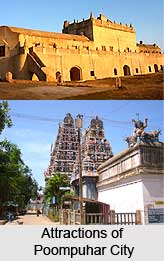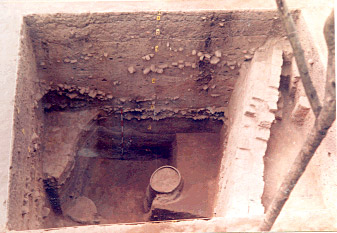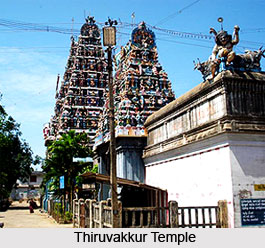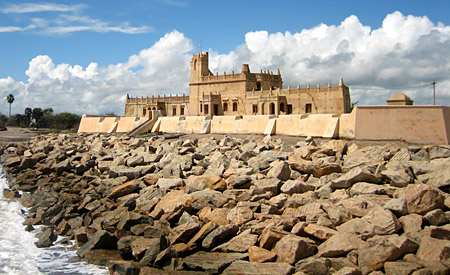Introduction
 Poompuhar was the chief port of the Chola kingdom during the Sangam Age in the Tamil Nadu state of India. It was earlier known as Kaviripoompattinam. The ancient glory of the Tamils can be visualised by seeing this port town. Sangam literature and the two great epics Silappadhikaram and Manimekalai informs about its glory. It was an international seaport and many languages were spoken by the merchants of various countries.
Poompuhar was the chief port of the Chola kingdom during the Sangam Age in the Tamil Nadu state of India. It was earlier known as Kaviripoompattinam. The ancient glory of the Tamils can be visualised by seeing this port town. Sangam literature and the two great epics Silappadhikaram and Manimekalai informs about its glory. It was an international seaport and many languages were spoken by the merchants of various countries.
The Poompuhar city had separate quarters for foreigners. Both day and night bazaars called Nalangadi and Allangadi used to remain busy in selling a plethora of articles like spices, gold, fancy wear, garments, liquor, pearls and precious stones and various edibles. Now-a-days, the big town has reduced to a small village. But the evidences of its past glory in and around Poompuhar can be seen yet.
History of Poompuhar
The travelogues of Periplus and Merris Erithroly, Ptolemy and Pliny describes about antiquity of this port. The reference of this ancient town can be seen in the Pali literature like Milindapanha, Buddha Jataka tales, Abithama Avathar and Buddha Vamsakatha. About 2000 years ago, Buddhism flourished here. The evidences of it were found out of the donation of a pillar by a Buddhist Somaya Bikkuni of Poompuhar during the second century B.C. The Brahmi inscriptions of 2nd century B.C. also have the mention of the city.
The inscription at Sayavanam temple in Poompuhar also tells about its history. The Chola kings of the Sangam Age ruled the city with pride and decorated it in various ways. The mention of a great festival called Indra Vizha devoted to Lord Indra is found in most of them. Evidences have been found of its persistence till the later Chola period.
Plan of Poompuhar City
The plan of Poompuhar city is derived from various literary evidences. The city was divided into two well marked divisions as Pattinappakkam and Maruvurpakkam. The marketplace of Poompuhar was sandwiched in between Nalangadi, the day market, and Allangadi, the night bazaar.
The seashore was occupied by ferocious undaunting fisher folks. The warehouses were also located there. Artisans, merchants, sweet-vendors, butchers, potters and diamond-cutters lived in Maruvurpakkam.
Kings, nobles, elite citizens, rich traders and farmers, physicians, astrologers, the king`s barracks and court dancers lived in Pattinappakkam.
Vellidai Murugan, Elanchi Mandram, Nedunkal Mandram, Bootha Chatukkam and Pavai Mandram were located in Pattinappakkam.
The city also had well laid-out gardens like Elavanthigai Cholai, Uyya Vanam, Champapathi Vanam and Kaveri Vanam. Temples for Lord Siva, Chathukka Bootham, Indra, Balarama, Soory (Sun), Machathan, Chandra (Moon), Arugan (Jain) and Thirumal (Vishnu) were there besides Buddha stupas and seven Buddha vihars, Champapathi Amman temple, brick idols and Ulagu Arivai Mandram.
There were avenues and separate sacred passages for temple idols to take bath in the river. There were ring wells on the fringes of the city. There was a separate quarter for foreigners besides separate marketplaces.
All along the river banks, cool and shady trees were planted. This in short is the plan of Kaviripoompattinam or Poompuhar. `Puhar` means estuary and the city was situated at the estuary of the only perennial river of Cauvery.
Excavation at Poompuhar
The excavations conducted by the Archaeologists have unearthed several interesting evidences supporting the literary evidences of Poompuhar. The first excavation was done in 1910.
 A large number of ring wells were found by the Archaeological Survey of India near the seashore. The existence of various buildings was confirmed by the excavations near Champapathi Amman and Pallavaneswaram temples at Poompuhar. In Keezhaiyur, the remains of a brick building and a boat jetty were discovered. During this excavation, a water reservoir and the remains of several buildings were also found. Relics of a sixty feet Buddha vihar was found in Pallavaneswaram.
A large number of ring wells were found by the Archaeological Survey of India near the seashore. The existence of various buildings was confirmed by the excavations near Champapathi Amman and Pallavaneswaram temples at Poompuhar. In Keezhaiyur, the remains of a brick building and a boat jetty were discovered. During this excavation, a water reservoir and the remains of several buildings were also found. Relics of a sixty feet Buddha vihar was found in Pallavaneswaram.
This excavation at Poompuhar also revealed a Buddha marble paadha (feet of Buddha) with holy symbols similar to those at Amaravati and Nagarjunakonda. The coins used by the early Chola Karikalan period were also found out in this excavation. Moreover, an ancient Roman copper coin was recovered at Vellaiyan Iruppu. The findings contained the copper coins of Rajaraja Chola and an eighth century gold-plated copper statue of Buddha in meditation. This Buddha statue was unearthed in Melaiyur in 1927.
Recently, another excavation was conducted by the Tamil Nadu Archaeological Department. During this excavation, they have discovered the remains of several buildings. This department in collaboration with The National Institute of Oceanography, Goa, has launched an offshore exploration of Poompuhar. It is expected to bring out the magnificence of this former international seaport of South India.
Interesting places in Poompuhar
There are lots of places in Poompuhar, which are watch worthy. Some of them are given here:
Silappathikaram Art Gallery
 This art gallery of Poompuhar has a beautiful seven-tier building of exquisite sculptural value. Among these, the first storey is 12 feet high and the following storey each has a height of 5 feet atop of which is erected a kalasam with a height of 8 feet. The total height of it thus becomes 50 feet.
This art gallery of Poompuhar has a beautiful seven-tier building of exquisite sculptural value. Among these, the first storey is 12 feet high and the following storey each has a height of 5 feet atop of which is erected a kalasam with a height of 8 feet. The total height of it thus becomes 50 feet.
The art gallery here depicts the scenes from one of the five major epics of Tamil `Silappathikaram`. It was opened in 1973. These exquisite scenes are immortalized in stone on the walls of the gallery. In brief, it can be considered as a treasure-house of Tamil Nadu.
The Makara Thorana Vayil
The whole structure of this Makara Thorana Vayil can be seen at the entrance of the Art Gallery. It was designed following the model of Magara Thorana Vayil found in Surulimalai Mangala Devi temple.
Ilanji Mandram, Pavai Mandram, Nedungal Mandram and Kotrappandal:
These were re-erected here in Poompuhar with their artistic splendour. The epic poetry of the Tamils Silappathikaram mentions about all these public places. They served various purposes besides being attractive.
Ilanji Mandram is a beautiful place with a miracle tank which cured all illnesses. Nedungal Mandram is a pillar of grandeur. It is believed that those afflicted with mental disorder or those who have been poisoned or bitten by snake can be cured if they go round and worship the pillar.
Pavai Mandram is a place of justice. It is said that if any injustice was done the Pavai (idol) there would shed tears. Kotrappandal was the ornamental shamiana presented by the king of the Vajjra country.
Thirusaikkadu temple of Poompuhar
It is situated 2 kms away from Poompuhar estuary. It is a Siva temple of Thiru Sayavaneswarar and Kuyilinum Inia Nanmozhi Ammai. The Saivaite Saints or Nayanmars have sung hymns in praise of this temple. Chola inscriptions are also found here.
Thiruppallavaneswaram temple of Poompuhar
This is an ancient and beautiful temple in Poompuhar. Iyarpagai Nayanar and Pattinathar and the hero and heroine of Silappathikaram, Kovalan and Kannagi were also born here. The Pallavas built this temple. The inscription of Vikrama Chola terms this place as `Puharnagaram`, Puhar city.
Melapperumpallam and Keezhap-perumpallam
These two places are situated very near to Poompuhar and Thiruvengadu. The Chola inscriptions can be seen in the Valampurinathar temple at Melapperumpallam. Nayanmars are said to have sanctified this temple in their hymns.
Keezhapperumpallam is situated at a distance of 2 km from Poompuhar. It is one of the Navagrahas, Kethu (serpent`s tail) and has a separate sanctum here.
Thiruvakkur temple of Poompuhar
It is a famous Siva temple of Poompuhar. It is constructed on Madakkoil (Storeyed Temple) pattern. Nayanmars have sung hymns on this temple. Sirappuli Nayanar, one of the 63 Saivaite saints, was born here.
Semponnarkoil temple of Poompuhar
This temple has important historic connotation. It is also called Thirusemponpathi in Thevaram. It is near Poompuhar on the bus route to Tranquebar (Tharangambadi).
Punjai temple of Poompuhar
It is a beautiful Siva temple, situated near Semponnarkoil. It is hail for the architectural wonders of the Cholas.
Thirukkadaiyur temple of Poompuhar
It is one of the eight temples (Atta Veerattanam), which glorifies the heroic victories of Lord Siva. It is situated on the road to Tranquebar from Mayiladuthurai. A beautiful bronze representation of Siva releasing Markandeya from the clutches of Yama, the God of Death and making him a perpetual youth can be seen here. The rope marks of Yama can be seen in the lingam here.
This place of Poompuhar is also known for its fame in patronizing Bharathanatyam as evidenced by the inscription of Kulottunga Chola III. It is also a famous Sakthi Sthalam. The presiding deity here is known as `Amirthagateswara` (Lord of the nectar pot). People celebrate their 60th birthday here so that they are rewarded with longevity by the grace of this God.
Anantha Mangalam
This place is situated near Thirukkadaiyur and is famous for its `Dasa Bhuja Veera Anjaneya` (Ten-headed Hanuman).
Nangoor
There are eleven of the 108 holy places of Vaishnavaites situated near Nangoor. The Nangoor Vishnu temples were sanctified by Thirumangai Alwar, one of the 12 Vaishnavaite Saints. The stucco figure of Nara Narayana in one of these temples is one of the best architectural works.
Thalaignayiru temple
This temple is situated near Poompuhar and contains an interesting inscription prescribing rules for the election of the village assembly. As per those prescribed rules, those who were not members for the previous ten years and above 40 years alone are eligible to contest an election.
Tharangampadi
 This place is situated on the coast of the Bay of Bengal, south of Poompuhar. Here, the first Tamil printing press was erected and casting of Tamil alphabets was done. The Bible was printed here by the Christian missionary as the first printed book in Tamil.
This place is situated on the coast of the Bay of Bengal, south of Poompuhar. Here, the first Tamil printing press was erected and casting of Tamil alphabets was done. The Bible was printed here by the Christian missionary as the first printed book in Tamil.
Tharangampadi was also a site of Danish settlement. It has the remnants of the Dansborg Fort built by Ore Godde, the Commander of the Royal Dutch Navy in the 17th century. The walls of the forts are ruined now but the rest of the buildings are still in good condition.
The Church of Zion
This church of Poompuhar was built in 1701 in the corner of King Street and Queen Street. It was renovated in the years 1782, 1784, 1800 and 1839. Now, the church has an impressive vaulted roof.
The Town Gateway
The town gateway of Poompuhar is 200 years old and has historical and architectural values.
Danish Fort of Poompuhar
This fort exhibits Danish architecture and is under the control of Tamil Nadu Archaeological Department. It has an archaeological museum open to public on all days except Fridays.
Masilamaninathar Temple of Poompuhar
The Pandya king Maravarman Kulasekara built this temple in 1305 AD. It has an outstanding architectural beauty, which attracts lots of visitors. The front portion of the fort has damaged due to sea erosion but still attracts the onlookers.
Rehling`s Gaid
It is the biggest building in Tranquebar of Poompuhar. This was named after Johannes Rehling who was the Danish governor and owned this house between 1830 and 1841. At present, the St. Theresa`s Teachers Training College can be seen functioning here and it is well preserved.
British Collector`s House
It is situated on the eastern end of King`s Street opposite the Dansborg Fort. It is another important landmark 150 years old with beautiful round columns, a central courtyard and a garden.



















